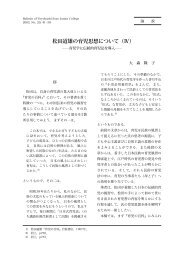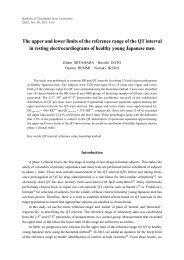A Critical Evaluation of Dumping IN INTERNATIONAL TRADE
A Critical Evaluation of Dumping IN INTERNATIONAL TRADE
A Critical Evaluation of Dumping IN INTERNATIONAL TRADE
Create successful ePaper yourself
Turn your PDF publications into a flip-book with our unique Google optimized e-Paper software.
142<br />
<br />
Japan, Eastern European countries, and a few<br />
members. The international organization that<br />
developing countries including China, Korea,<br />
Taiwan, and Yugoslavia have been the targets.<br />
A dumping investigation has three possible<br />
preceded it was the General Agreement on<br />
Tariffs and Trade (GATT), which deals with<br />
trade in goods, and has the provisions for anti-<br />
outcomes: the rejection <strong>of</strong> the claim, the<br />
levying <strong>of</strong> an antidumping duty, or the<br />
negotiation <strong>of</strong> a voluntary price increase with<br />
dumping and subsidies and countervailing<br />
measures. The present rules on antidumping<br />
measures are a result <strong>of</strong> the Uruguay Round<br />
the party accused <strong>of</strong> dumping. The average<br />
ad valorem (duty imposed at a percentage <strong>of</strong><br />
the value) equivalent <strong>of</strong> antidumping measures<br />
negotiations (1986–1994). The Uruguay<br />
Round version is part <strong>of</strong> the WTO agreement<br />
and applies to all members.<br />
between 1980 and 1985 was 23 percent, with<br />
peaks at 50 percent or more. Imports <strong>of</strong><br />
products subject to antidumping investigations<br />
Antidumping measures: if a company<br />
exports a product at a price lower than the price<br />
it normally charges on its own home market,<br />
have fallen on average to half their initial level<br />
within five years <strong>of</strong> initiation <strong>of</strong> an<br />
investigation (Finger, 1996: 221–236).<br />
it is said to be “dumping” the product. Is this<br />
unfair competition? The WTO agreement does<br />
not pass judgement. Its focus is on how<br />
<br />
C. International Agreements<br />
Some countries have their own laws to<br />
governments can or cannot react to dumping.<br />
It disciplines antidumping actions, and it is<br />
<strong>of</strong>ten called the “Anti-<strong>Dumping</strong> Agreement.”<br />
<br />
combat unfair trade practices from foreign<br />
countries. Since these laws are designed to<br />
cope with international trade disputes, they<br />
The WTO agreement allows governments to<br />
act against dumping where there is genuine<br />
“material” injury to the competing domestic<br />
need to have something in common across the<br />
world. The World Trade Organization (WTO),<br />
commonly referred to as the world trading<br />
industry. In order to do that, the government<br />
has to be able to show that dumping is taking<br />
place, calculate the extent <strong>of</strong> dumping (how<br />
system, provides the definition for dumping<br />
and countervailing activities, and guide-lines<br />
to take counter active measures against unfair<br />
much lower the export price is, compared to<br />
the exporter’s home market price), and show<br />
that the dumping is causing injury.<br />
trade partners. The U.S., EC, Canada, and<br />
other countries have been modifying their laws<br />
to conform to the spirit <strong>of</strong> the WTO.<br />
Subsidies and countervailing measures:<br />
agreement on subsidies and countervailing<br />
measures does two things. It disciplines the<br />
The World Trade Organization (WTO) is<br />
an international agency whose purpose is to<br />
help trade flow as smoothly as possible in a<br />
use <strong>of</strong> subsidies and regulates the actions<br />
countries can take to counter the effects <strong>of</strong><br />
subsidies. A country can use the WTO’s<br />
system based on rules, to settle trade disputes<br />
between governments, and to organize trade<br />
negotiations. By May 1997, it had 131<br />
dispute settlement procedure to seek the<br />
withdrawal <strong>of</strong> the subsidy or the removal <strong>of</strong><br />
its adverse effects (GATT, 1998)




